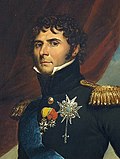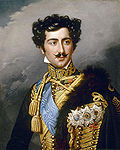| Viceroy of Norway | |
|---|---|
| Vice-Konge | |
 Painting of the Norwegian Crown Prince's Crown, by Johannes Flintoe | |
| Residence | The Royal Palace |
| Appointer | King of Norway |
| Formation | 4 November 1814 |
| First holder | Charles John |
| Final holder | Gustav |
| Abolished | 30 June 1891 |
| Succession | Appointment |
The Viceroy of Norway (Constitutional Danish: Vice-Konge) was the appointed head of the Norwegian Government in the absence of the King, during the era of the Union between Sweden and Norway. The role was essentially the same as that of the Governor-general, which has led to confusion as to who filled which office. Decisive, however, is that the title of Viceroy could only be held by the crown prince, or his oldest son, when he had come of age. Commoners with a similar mandate were merely styled Statholder (Governor-general).



